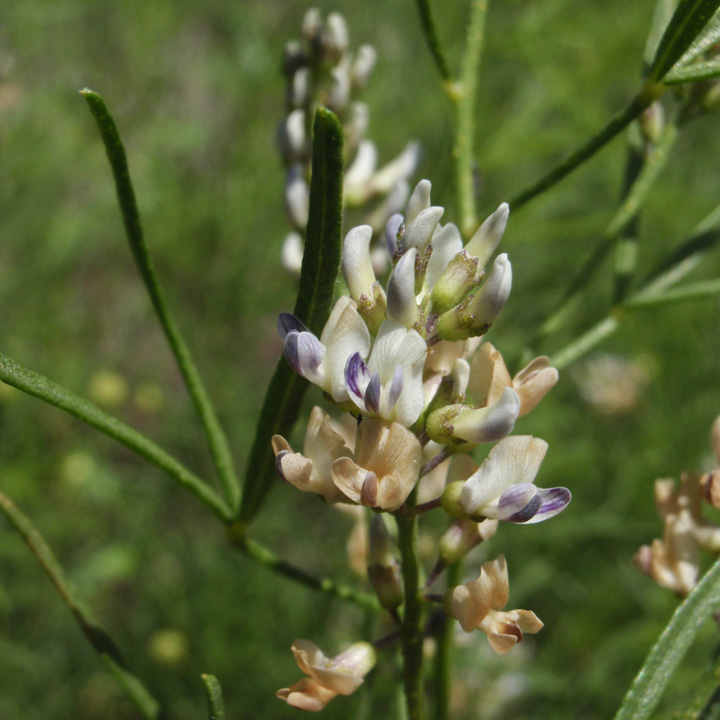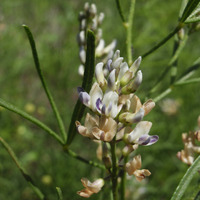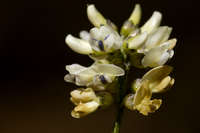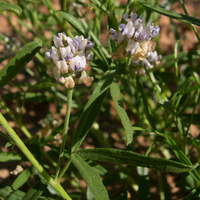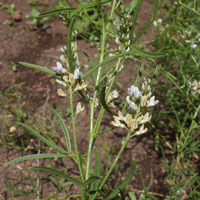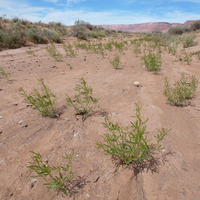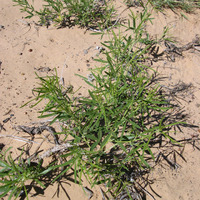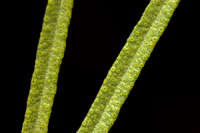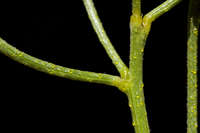Duration: Perennial
Nativity: Native
Lifeform: Forb/Herb
General: Perennial herb, 15-70 cm tall, growing in clumps of stems from a rhizome; stems with 5 or more elongated internodes, glabrous or sparsely strigose, and gland-dotted.
Leaves: Alternate along the stems, on petioles 1-3 cm long; leaves palmately 3-foliolate, with leaflets 1-4 cm long, narrowly lanceolate, yellow-green and gland-dotted, sparingly strigose on both sides or glabrous above; leaves persisting through the flowering season.
Flowers: White to purple, in short dense axillary racemes, 1-2 cm long, with 1-3 flowers per node and 5-41 flowers in each raceme; flowers about 0.5 cm long, with pea-flower morphology (papilionoid); calyx campanulate (bell-shaped) and gland-dotted, 2-3 mm long, topped with 5 short, obtuse teeth; corolla 4-7 mm long, white, yellowish, or purple-blue.
Fruits: Pods globose, about 5 mm long, glabrous or hairy, glandular; containing 1 seed.
Ecology: Found in sandy soils, often in openings and on flats from 4,000-7,500 ft (1219-2286 m); flowers May-September.
Distribution: WA and Saskatchewan, south to CA, AZ, NM, and OK
Notes: This perennial herb is noticable due to its stems and leaves being covered with small glands, which can range in color from greenish-white to black. Look also for the clusters of slender stems creating an almost broom-like growth form; long, narrow leaves which come in 3's; and short clusters of pea-flowers which are mostly embedded among the leaves. The flowers are most often whitish with a tint of purple, especially at the tip of the keel petal. The stems and leaves are hairless or may be slightly strigose, and the fruits are spherical and fall off the plant promptly.
Ethnobotany: Used medicinally to treat headaches, stomachaches, menstrual pain, and venereal disease; rubbed on skin to combat dryness, itching, and sores; the root and leaves were chewed for sore throat; also used ceremonially.
Etymology: Psoralidium is a diminutive of the closely related genus Psoralea; lanceolatum means lance like, referring to the shape of the leaves.
Synonyms: Numerous, see Tropicos
Editor: SBuckley 2010, AHazelton 2017
Much like no. 1 [Psoralidium tenuiflorum (Pursh) Rydb.]; petioles mostly 1-2 cm; racemes short, congested, often surpassed by the lvs; fls white or the keel blue; cal-teeth subequal; fr subglobose, 4-5 mm; 2n=22. Dry, sandy soil; Wash. to Calif., e. to N.D., w. Io., and Okla. May-Sept. (Psoralea l.)
Gleason, Henry A. & Cronquist, Arthur J. 1991. Manual of vascular plants of northeastern United States and adjacent Canada. lxxv + 910 pp.
©The New York Botanical Garden. All rights reserved. Used by permission.


